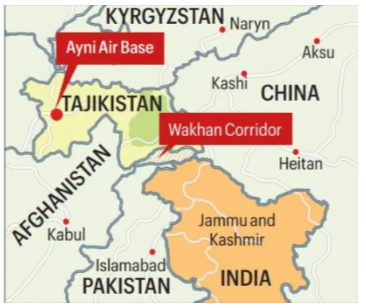Syllabus:
GS-2: Effect of policies and politics of developed and developing countries on India’s interests, Indian diaspora.
GS-3: Role of external state and non-state actors in creating challenges to internal security.
Context: India has withdrawn from its only full-fledged overseas Ayni airbase in Tajikistan that gave it a strategic heft in Central Asia.
More on the News
- At its peak, around 200 Indian Army and IAF personnel, along with a few Sukhoi-30 MKI jets, were stationed at the airbase. Following the expiration of the agreement with Tajikistan, India began withdrawing its staff and assets in 2022.
About the Ayni Air Base

- Ayni Airbase is also called Gissar Air Base. It is located about 10 km west of Dushanbe, the capital of Tajikistan.
- It was India’s only full-fledged overseas military base, providing a critical strategic foothold in Central Asia.
- Its geography makes it particularly strategic — it lies just 20 km from the Wakhan Corridor — which separates Tajikistan and Pakistan — and around 600 km from Pakistan-occupied Kashmir and close to China’s Xinjiang province.
- The airbase was also used by India to evacuate its nationals after the Taliban took control of Kabul in August 2021.
Reasons for Withdrawal
- Conclusion of the Agreement: India operated the Ayni airbase under a lease agreement with Tajikistan from 2002, which expired in 2022. After the lease ended, India handed the base back and started withdrawing its personnel and equipment.
- Reluctancy in Lease Renewal: Tajikistan chose not to renew India’s lease due to pressure from Russia and China, two powerful neighbours keen to limit outside military presence in the Central Asian Region.
- Changing Geopolitics: The Taliban’s return in Afghanistan in 2021 reduced the base’s strategic importance for India, while China and Russia’s growing influence in Central Asia made India’s position tougher.
- Operational Challenges: The airbase was mainly used for support and humanitarian work, with limited combat operations. Its remote location and logistical difficulties made long-term operations costly and complex.
- Shifted Priorities: India refocused its military strategy towards strengthening naval capabilities in the Indian Ocean and building partnerships in nearby countries like Oman’s Duqm Port, moving away from distant land bases like Ayni.
Strategic Implications for India
- Loss of Strategic leverage: India’s exit from Ayni ends its only foreign military base, removing a key forward position in Central Asia and limiting its ability to project power near Afghanistan, PoK, and Xinjiang.
- Reduced Military and Intelligence Reach: With Ayni gone, India loses a crucial surveillance and operational hub, weakening its monitoring of terrorism, narcotics routes, and Chinese military activity in the Wakhan Corridor and Xinjiang.
- Diminished Diplomatic Influence: The base had reinforced India’s “Connect Central Asia” policy. Its loss reflects declining influence in regional forums like the SCO, where China and Russia dominate.
- Greater Space for Rival Powers: India’s withdrawal strengthens Russian and Chinese sway over Tajikistan and the region, expanding China’s operational reach along routes India once tracked.
- Shift in Defence Posture: The setback highlights India’s difficulty in maintaining overseas bases amid big-power competition, pushing it toward maritime and Indo-Pacific partnerships instead.
- Economic and Logistical Losses: Under a 2002 bilateral agreement with Tajikistan, India spent around $80 million to renovate the airbase, which included repairing and upgrading the runway to a 3,200-metre.
- Setback for India’s foreign policy: India’s inability to retain or expand such overseas bases underscores gaps in India’s strategic planning and shows the fragility of its regional relationships.

